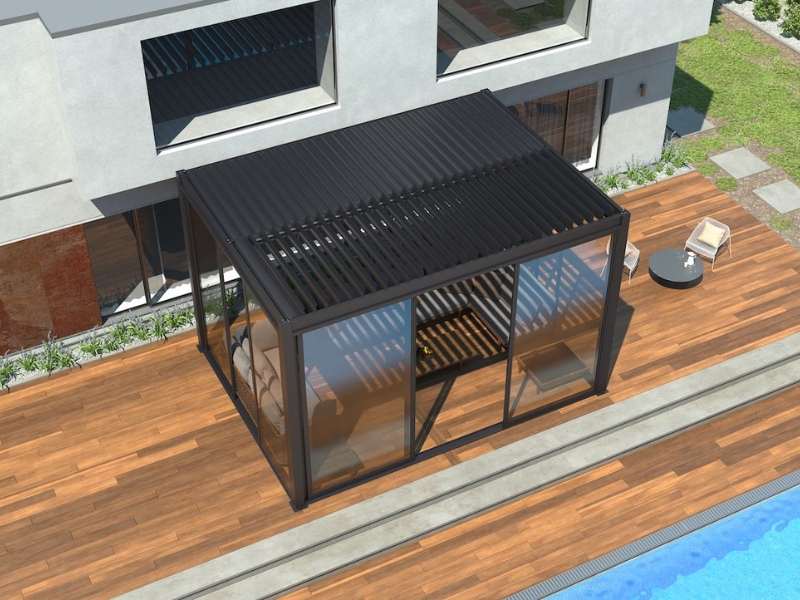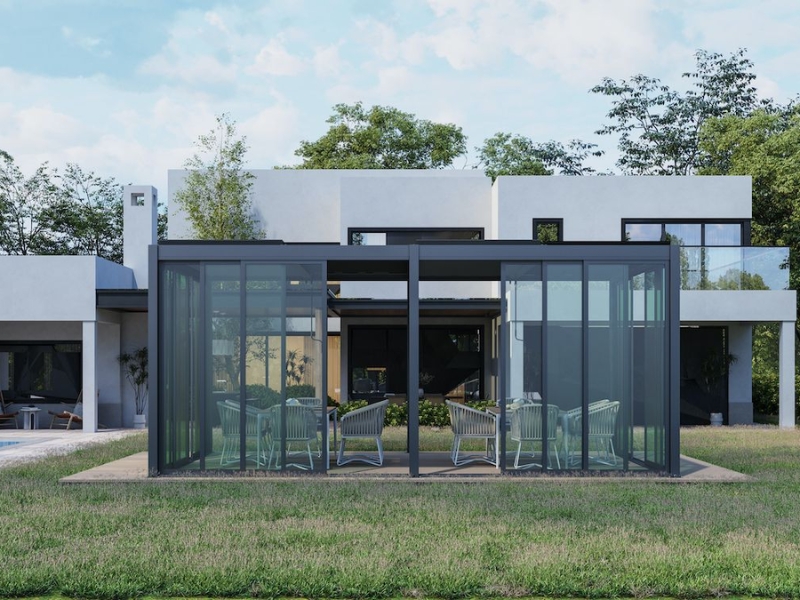Think Aussie weather’s too unpredictable for outdoor comfort? A fully enclosed pergola might just prove otherwise. Blending indoor control with outdoor charm, it can be the perfect escape from heat, humidity, and stormy afternoons. But is it up to scratch for Australia’s extreme climate? This article unpacks how a fully enclosed pergola handles our sun, storms, and chilly snaps, offering design tips, airflow strategies, and material insights tailored for harsh conditions.
What design choices help enclosed pergolas thrive in humid climates?
Staying cool and dry in humid regions takes more than a roof overhead. A smartly built, fully enclosed pergola helps sidestep mould, stale air, and discomfort from tropical conditions.
- Strategic orientation: Facing the pergola to catch cross-breezes allows constant airflow, even in sticky weather. Aligning the structure to take advantage of local wind patterns improves natural cooling and prevents condensation build-up.
- Openable side panels: Louver systems or bifold doors offer flexibility, allowing you to adjust ventilation as humidity levels shift. You can easily seal off the space during rain or open it wide on clear, breezy days.
- Integrated drainage design Features Sloped flooring, concealed gutters, and water-routing channels, which prevent pooling and reduce damage. This helps preserve structural integrity and keeps surrounding surfaces from becoming slippery or waterlogged.
- Moisture-resistant materials, such as aluminium, treated hardwood, and PVC panels, prevent swelling, rot, and decay in damp climates. These materials also reduce long-term maintenance needs in high-humidity zones.
- Insect screening solutions: Fine mesh on vents and adjustable windows deters pests common in humid environments, especially in the warmer months.
Humidity invites discomfort and deterioration, but with built-in airflow and smart drainage, your pergola will remain strong all summer. For even greater climate control and insulation, consider incorporating glazed glass doors for comfort and energy efficiency into your design.
How can enclosed pergola designs adapt to extreme Aussie temperatures?
Surviving summer scorchers and winter chills in the same space? It’s all about flexibility and thermal management. The right design decisions keep your fully enclosed pergola livable through four seasons.
- Insulated roof and wall panels: These regulate internal temperatures, keeping heat out and warmth in when needed. Rigid foam-core panels, also known as insulated sandwich panels, are highly effective in extreme climates.
- Glazed or UV-treated windows: Tinted or low-E glass reduces heat load and stops glare without darkening the space. It also protects furniture and floors from fading under harsh sun.
- Integrated shade systems, such as roller blinds, retractable screens, or thermal curtains, adapt to sun angles throughout the year. They allow for quick adjustment as conditions change, adding a layer of thermal control.
- Climate control fit-outs: Ceiling fans, space heaters, or ducted cooling units provide backup comfort in extreme weather conditions. These systems work best when supported by passive design, reducing energy costs.
Here’s a breakdown of key climate design strategies:
| Climate Challenge | Smart Design Feature | Benefit |
| Summer heat (40 °C+) | Insulated panels, reflective roofing | Keeps the interior cooler and brighter |
| Intense UV exposure | Low-E glass, retractable shades | Blocks harsh sun, prevents fading |
| Cold snaps | Thermal curtains, patio heaters | Maintains warmth during winter |
| Coastal weather | Powder-coated frames, sealed joints | Prevents corrosion and water damage |
With a design that responds to both heat and chill, your pergola won’t become unusable at either end of the thermometer. For long-term resilience, explore durable fully enclosed pergola models with weather-adaptive features already built in.
Does poor ventilation affect comfort in a fully enclosed pergola?

Absolutely—stagnant air is a recipe for discomfort. Without proper airflow, your fully enclosed pergola becomes muggy, musty, and downright unpleasant during hot spells or rainy days.
- Roofline vents or skylights: These release hot air that naturally rises, cooling the space without the need for mechanical systems.
- Opposing ventilation panels: Placing windows on opposite walls promotes natural circulation, avoiding hotspots.
- Ceiling fans and extractor systems: Help shift warm air out and pull in cooler outdoor air.
- Smart window placement: High-mounted openings allow hot air to escape while maintaining security and privacy.
When circulation fails, everything inside suffers—from furnishings to flooring. To keep things fresh, take cues from advice like winter warmth strategies for enclosed outdoor spaces, which offer airflow tips relevant even outside winter. Good airflow doesn’t just cool—it prolongs the lifespan of materials and keeps mould at bay.
What materials best protect a fully enclosed pergola from Aussie conditions?
Materials make or break a pergola’s lifespan. From sun to storms, building with weather-ready products ensures your space doesn’t fall apart before its time.
- Colorbond or polycarbonate roofing: UV-resistant, low-maintenance, and built for harsh Aussie conditions.
- Aluminium or galvanised steel framing: Resists corrosion and requires less upkeep than timber in exposed areas.
- Treated hardwood or composite cladding: Offers aesthetic appeal while resisting warping and water damage.
- Outdoor-grade seals and gaskets: Keep moisture and insects out while flexing with temperature changes.
Additionally, how you size and structure the pergola can impact how it withstands the elements. For more guidance, understanding how pergola dimensions shape outdoor living spaces—an innovative approach to scale and shape helps materials perform better in the long term.
How can you maintain airflow and keep a pergola cool when it’s fully enclosed?
Maintenance is more than an afterthought—it’s crucial to maintaining strong airflow and stable indoor comfort in your fully enclosed pergola. Ignoring filters, seals, or blocked vents can throw your temperature control out the window.
- Clean and test vents monthly: Build-up in mesh or grilles slows airflow, even in well-designed pergolas.
- Adjust seasonal settings on fans or air conditioners: Change the rotation or output direction to match hot or cool weather conditions.
- Inspect seals and joints every season: Look for warping or shrinking that could lead to air leaks or water intrusion.
- Wipe louvers and glass panels: Dust reduces the effectiveness of passive cooling systems and blocks cross-breezes.
Stay proactive and seasonal issues won’t sneak up on you. Consistent upkeep goes a long way. If you’re winterising your space, explore how to keep your pergola comfortably usable in winter—it’s all about sealing, circulation, and comfort layering.
Final thoughts
A fully enclosed pergola offers solid year-round comfort when built with the right materials and airflow in mind. Insulated roofs, sealed cladding, and passive ventilation all play key roles in managing Australia’s shifting conditions. With proper design and upkeep, your pergola won’t just survive harsh weather—it’ll stay enjoyable through all seasons. From UV-resistant finishes to flexible airflow systems, each choice adds up to a more resilient and functional space. If you’re refining your layout or planning a build, discover how Unique Pergolas supports seamless pergola projects with design ideas tailored to meet your outdoor goals.


